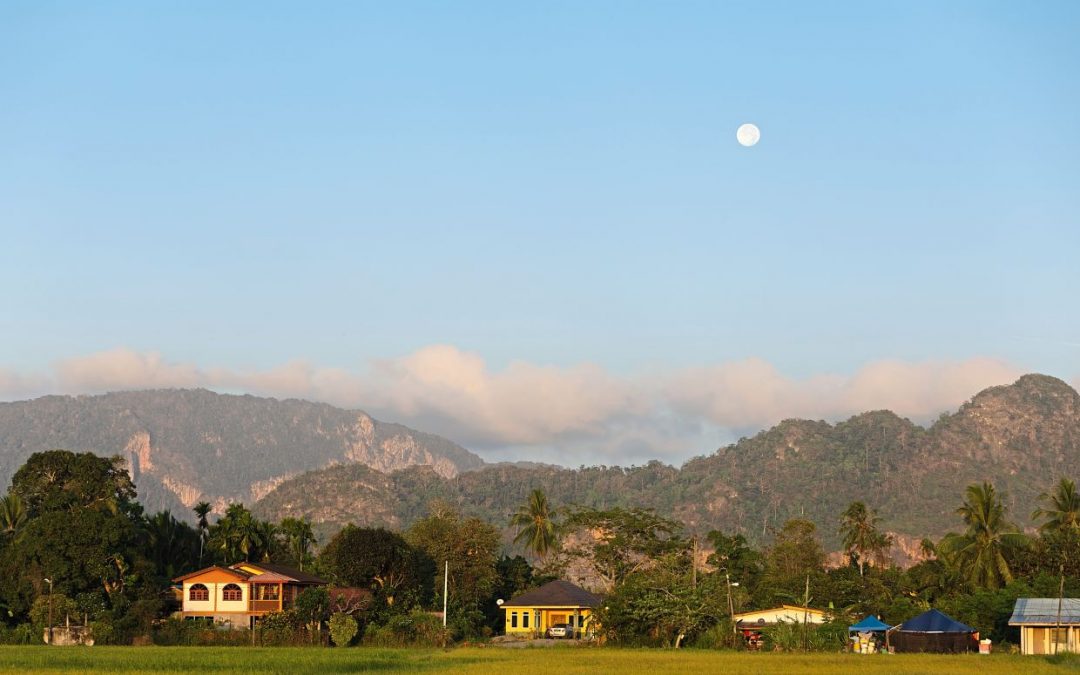The Nakawan range was made to arrest attention: sheer, nearly vertical hills rise from the flat plains to span 36km from the border of Thailand to the Andaman Sea.
This limestone beauty is Malaysia’s “Great Wall in the North”, separating Malaysia from Thailand.
Its chalky white cliff faces peek out from under cover of the semi-deciduous forest that adorns this charismatic range.
Many species of fig trees and meranti reach for the sky on these dry and rocky surfaces whose leaves turn red and yellow and shed once a year – a tropical autumnal season.
This is also a remarkable place geographically.
It is the country’s oldest and longest limestone range, a meeting point between the Indochine and the Nusantara, where the more arid landscapes in the north meet the humid south.
This distinctive location gives rise to an extended and more intense dry season, allowing many unique species to thrive.
Sunrise at the Nakawan Range, which is the oldest and longest continuous limestone hill in Malaysia.
Sunrise at the Nakawan Range, which is the oldest and longest continuous limestone hill in Malaysia.
The terrain in Perlis, especially that of Wang Kelian, is unique in Malaysia.
Paddy fields are pressed up against the 370 million-year-old limestone hills, creating dramatic sceneries. These karsts and hills also house many caves and crevices, some of which remain unexplored.
Bukit Rongkit on the edge of Wang Kelian has a deep crater – or “wang” in Thai – that is only visible and accessible from the peak. The mysteries that lie within remain uncovered.
These caves are also an important source of fresh water, with rivers emerging from them to feed the rice plains of Perlis. Some of these caves are easily accessible by the public, such as the old mining cave of Gua Kelam.
Apart from learning about the mining history of the nearby village of Kaki Bukit, there is also the chance to discover some of the amazing wildlife that thrives in the complete darkness of these cave systems, such as the Asian Leaf Turtle, which is usually found above ground and on higher elevations.
Indeed, Wang Kelian and the surrounding forests of the Perlis State Park are such remarkable destinations to come and experience the wealth of flora and fauna that Malaysia is one of only 17 countries on the planet to have the status of a “mega-biodiverse nation”.
From the peaks of the limestone ridges to the depths of the caves, life is teeming everywhere and some are incredibly easy to spot.
One of the main attractions of the area is the stump-tailed macaque (Macaca arctoides), a primate species that is usually found further north in the Asian continent up to the foothills of the Himalayas.
However, one population thrives in the valley of Wang Kelian.
This population does not cross the border to Thailand or descend further south to the rest of the peninsula. They remain uniquely Perlis-ian.
Locally referred to as beruk kentoi, these primates are known for their distinctive appearance, striking red facial markings, and stocky physique.
They move around mainly on the forest floor as they lack tails for balancing in trees and only climb trees to forage for young shoots, leaves and fruit.
They are not the only primate species that can be found in this spectacular limestone range.
The Perlis State Park, which wraps around the village of Wang Kelian, is home to seven species of primates, a remarkable count for this area of 5,000ha.
The light morph of the charismatic and endangered white-handed gibbon (Hylobates lar) or ungka tangan putih is easily heard and sighted in the area.
Only found in South-East Asia, these primates are known for their distinctive calls, often heard echoing through these forests.
They are highly acrobatic and often seen swinging through the trees. The Nakawan range is one of the most accessible places in Malaysia to see these beautiful apes in the wild.
Birds are in abundance at the Perlis State Park and in Wang Kelian.
The combination of limestone forests and village orchards provides a truly unique habitat for them to thrive.
White-Crested Hornbill is known for their striking appearance, with a white crest on their head that resembles a horn, and black feathers covering its body, tail, and wings.

Stump-Tailed macaque, one of the attractions at Perlis State Park

Lar Gibbon is hanging on the tree and can be easily heard and sighted.

Blue-Crowned Hanging Parrot found at the state park.

